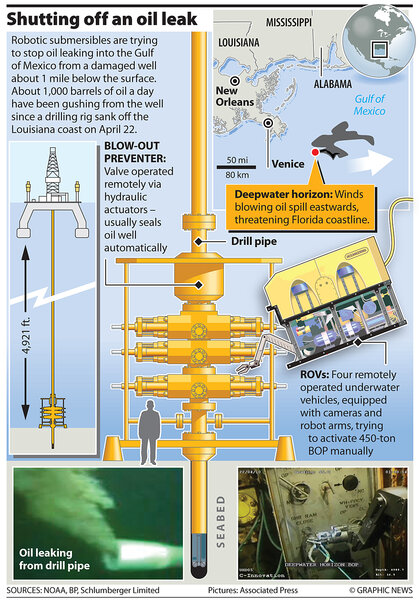Oil spill: Gulf of Mexico disaster 'growing by the moment'
Loading...
| Atlanta
Capping the renegade wellhead spewing 42,000 gallons of oil a day into the Gulf of Mexico will take an unprecedented effort by British Petroleum and federal agencies, who face mounting difficulties to contain the oil spill that threatens both environmental and political disaster.
The explosion, the sinking, and now the spill from the Transocean Deepwater Horizon oil rig couldn't have come at a worse time for President Obama and other proponents of expanding deepwater oil exploration off the US.
Though the accident is largely an aberration for the industry, which has made significant safety improvements during the past 40 years, it has raised tensions in states that could be affected by the president's decision last month to expand offshore drilling.
IN PICTURES: Louisiana oil rig explosion
"If this doesn't give somebody pause, there's something wrong," Florida Gov. Charlie Crist tells the Miami Herald.
"This is really sort of one of the nightmares for all the companies involved, and obviously the people who live along the coast are sort of helpless," says Tyler Priest, an oil industry historian at the University of Houston. "I'm sure it's going to galvanize the political opponents of expanded offshore leasing."
Louisiana's fisheries
The spill endangers the fragile fish and shrimp nurseries of the Louisiana wetlands, which could be affected as early as Saturday. Up until this weekend, the Coast Guard and rig operator British Petroleum remained adamant that the spill could be contained. But environmentalists and lawmakers who oppose more coastal drilling are growing skeptical.
"The explosion, ensuring fire, and continuing spill raise serious concerns about the industry's claims that their operations and technology are safe enough to put rigs in areas that are environmentally sensitive or are critical to tourism or fishing industries," Sen. Bill Nelson (D) of Florida writes in an April 26 letter requesting congressional hearings on exploration safety.
The spill presents a paradox for Louisiana. Avid defenders of the oil industry, Louisiana shoreline communities now face the greatest danger from the spill, which could threaten the region's prolific commercial and sport fishing industries.
"We're very concerned that east of the Mississippi River, based on currents and winds we're dealing with now, this oil will reach the shore," Chuck Wilson, a Louisiana State University oceanography and coastal sciences professor, tells CNN. "That could be a huge environmental problem and a significant financial blow to fisheries."
Deeper exploration, harder cleanups
A blowout on the Ixtoc I rig in 1979 off the coast of Mexico spilled 33,000 barrels of oil a day, threatened the coast of Texas, and took nine months to contain. Technologies and techniques for containing oil spills have improved since then, but challenges have also increased.
The current incident demonstrates the risks and degree of difficulty of the global gambit to go ever further afield into the earth's deep crevasses to find oil. Trying to shut off a well 5,000 feet below the ocean surface has never been done.
"The depth complicates everything," says Robert Bryce, author of "Power Hungry: The myths of 'green energy' and the real fuels of the future." "This is a disaster that appears to be growing by the moment."
Shut out of more traditional exploration fields in developing countries, Transocean, the driller, and BP, the field developer, are at the forefront of efforts to expand the search for hydrocarbons.
Early reports were that BP workers using four remote-piloted subs had managed to jam the 5,000-foot "riser" from the well to the surface, These reports were wrong, with the Coast Guard saying Monday that the leak was not contained, but had, in fact, tripled in size in 24 hours.
The riser is now crumpled like an old garden hose in the Mississippi Canyon, leaking crude from at least two places, and feeding a spill that now measures 80 by 42 miles, more than six times the footprint of Los Angeles.
Attempts to stem the flow will focus on using another semi-submersible rig to drill a "relief" well to depressurize the main wellhead so it can be capped. The company is also already building a kind of "sombrero" dome to contain the oil. BP is also increasing hydraulic pressure to emergency-trigger various valves at the wellhead site to stem the flow, but those efforts have so far been unsuccessful.
BP CEO Tony Hayward remained confident the company could contain the spill before it caused environmental damage. In a statement, Mr. Hayward said better weather “combined with the light, thin oil we are dealing with has further increased our confidence that we can tackle this spill offshore."
Related:
Oil rig explosion unmasks 'dangerous myth' of safety, lawmakers say
Why do so many oil spills happen?
Transocean Deepwater Horizon oil rig explosion shows new risks






